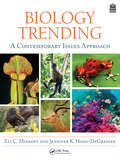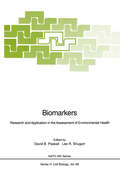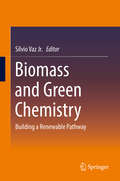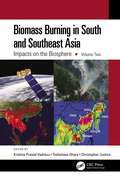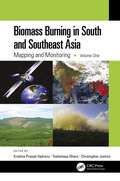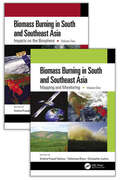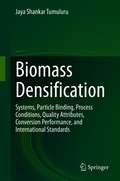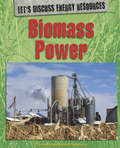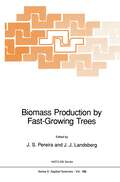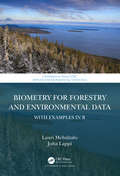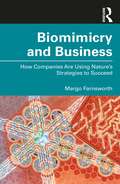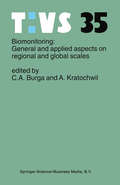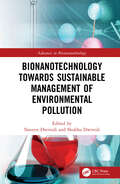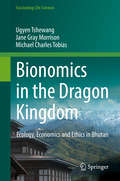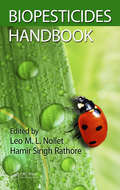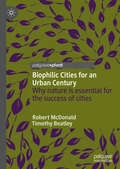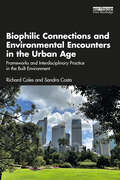- Table View
- List View
Biology Trending: A Contemporary Issues Approach
by Eli Minkoff Jennifer K. Hood-DeGrenierBiology Trending is a truly innovative introductory biology text. Designed to combine the teaching of biological concepts within the context of current societal issues, Biology Trending encourages introductory biology students to think critically about the role that science plays in their world. This book features many current and relevant topics, including sea-level changes and ocean acidification; CRISPR/Cas9, opioid abuse, Zika, Ebola, and COVID-19; threats to biodiversity, and cancer immunotherapies. It is accompanied by digital Instructor and Student Resources to support teaching and learning.Key Features Adopts an "issues approach" to teaching introductory biology Up-to-date sections throughout, including climate change, CRISPR, new hominids, COVID-19, and new cancer therapies, among many others Suitable for both major and nonmajor courses More succinct for ease in teaching and more affordable for students High-quality illustrations help to elucidate key concepts This book is extended and enhanced through a range of digital resources that include: Long-form and open-response self-testing resources to test understanding and apply knowledge Visual simulations to demonstrate evolutionary processes Web links and bibliographic resources to expand knowledge Time-saving instructor resources such as PowerPoint slides, activity and assignment ideas, and comprehensive lesson plans Related TitlesBard, J. Evolution: The Origins and Mechanisms of Diversity (ISBN 9780367357016).Prothero, D. Vertebrate Evolution: From Origins to Dinosaurs and Beyond (ISBN 9780367473167)Johnson, N. A. Darwin’s Reach: 21st Century Applications of Evolutionary Biology (ISBN 9781138587397)
Biology Trending: A Contemporary Issues Approach
by Eli Minkoff Jennifer K. Hood-DeGrenierBiology Trending is a truly innovative introductory biology text. Designed to combine the teaching of biological concepts within the context of current societal issues, Biology Trending encourages introductory biology students to think critically about the role that science plays in their world. This book features many current and relevant topics, including sea-level changes and ocean acidification; CRISPR/Cas9, opioid abuse, Zika, Ebola, and COVID-19; threats to biodiversity, and cancer immunotherapies. It is accompanied by digital Instructor and Student Resources to support teaching and learning.Key Features Adopts an "issues approach" to teaching introductory biology Up-to-date sections throughout, including climate change, CRISPR, new hominids, COVID-19, and new cancer therapies, among many others Suitable for both major and nonmajor courses More succinct for ease in teaching and more affordable for students High-quality illustrations help to elucidate key concepts This book is extended and enhanced through a range of digital resources that include: Long-form and open-response self-testing resources to test understanding and apply knowledge Visual simulations to demonstrate evolutionary processes Web links and bibliographic resources to expand knowledge Time-saving instructor resources such as PowerPoint slides, activity and assignment ideas, and comprehensive lesson plans Related TitlesBard, J. Evolution: The Origins and Mechanisms of Diversity (ISBN 9780367357016).Prothero, D. Vertebrate Evolution: From Origins to Dinosaurs and Beyond (ISBN 9780367473167)Johnson, N. A. Darwin’s Reach: 21st Century Applications of Evolutionary Biology (ISBN 9781138587397)
Biomarkers: Research and Application in the Assessment of Environmental Health (Nato ASI Subseries H: #68)
by David B. Peakall Lee R. ShugartBiological markers used to assess the effects of environmental pollution have attracted considerable attention from regulatory agencies and are currently under evaluation at a number of research facilities throughout the world. However promising a biomarker-based biomonitoring approach may be, the development of this concept is complicated by a range of technical issues. This book provides a conceptional framework for research and application of biomarkers. International experts on biomonitoring have formulated a unified strategy for the development and validation of biomarkers in assessing environmental health as well as appropriate protocols for their implementation and interpretation in a biological monitoring program.
Biomass and Green Chemistry: Building a Renewable Pathway
by Sílvio Vaz Jr.This book investigates the main vegetable biomass types, their chemical characteristics and their potential to replace oil as raw material for the chemical industry, according to the principles of green chemistry. Authors from different scientific and technical backgrounds, from industry and academia, give an overview of the state of the art and ongoing developments. Aspects including bioeconomy, biorefineries, renewable chemistry and sustainability are also considered, given their relevance in this context. Furthermore, the book reviews green chemistry principles and their relation to biomass, while also exploring the main processes for converting biomass into bioproducts. The need to develop renewable feedstock for the chemical industry to replace oil has been identified as a major strategic challenge for the 21st century. In this context, the use of different types of vegetable biomass – starch, lignocellulosic, oleaginous, saccharide and algae – can be seen as a viable alternative to the use of non-renewable, more expensive raw materials. Furthermore, it offers a model for adding economic value to the agro industrial chains such as soybean, sugarcane, corn and forests, among others. This will in turn contribute to the sustainability of a wide range of chemicals, mainly organics and their transformation processes, which are widely used by modern society.
Biomass Burning in South and Southeast Asia: Impacts on the Biosphere, Volume Two
by Krishna Prasad Vadrevu Toshimasa Ohara Christopher JusticeBiomass burning is one of the most important sources of greenhouse gas emissions and aerosols in South and Southeast Asia and greatly impacts other countries through transboundary air pollution. With contributions from leading scientists, this volume offers an interdisciplinary perspective on the impacts of biomass burning on the land resources, climate, and the atmosphere. It showcases several examples linking top-down remote sensing, bottom-up ground-based measurements, and an integrated modeling to address the impacts of biomass burning and land–atmosphere interactions. It is a valuable guide for readers in atmospheric science, ecology, spatial geography, remote sensing, and GIS. This book is unique as it highlights the sources and the causes of biomass burning and atmospheric research in South and Southeast Asia. It explains the latest tools and techniques, in particular the use of satellite remote sensing and geospatial technologies for fire mapping, monitoring, and land cover/land use change. It focuses on large spatial scales integrating top-down and bottom-up methodologies. It addresses the pressing issues of air pollution rampant in South and Southeast Asia. It includes contributions from global experts working on biomass burning projects in the USA, Japan, South/Southeast Asia, and Europe. The contents of this book will appeal to students and professionals using remote sensing and geospatial techniques, including geographers, ecologists, atmospheric and environmental scientists, and all who are interested in biomass burning pollution.
Biomass Burning in South and Southeast Asia: Mapping and Monitoring, Volume One
by Krishna Prasad Vadrevu Toshimasa Ohara Christopher JusticeVolume 1 of a two volume set, this book is a self-contained, state-of-the-art analysis of remote sensing, ground-based, and spatial techniques used for characterizing biomass burning events and pollution. It is a collective achievement of renowned scientists working throughout South and Southeast Asia. They discuss the complexity of vegetation patterns, biomass characteristics, fire distribution, drivers of fires, and several examples of the use of novel satellite algorithms for mapping and monitoring biomass burning events. The book is highly interdisciplinary and integrates earth science and environmental science including ecology, fire science, spatial geography, remote sensing, and geospatial technologies. Unique in its discussion of the sources and the causes of biomass burning and atmospheric research in South and Southeast Asia. Explains how remote sensing and geospatial technologies help the mapping and monitoring of biomass burning events and their impacts. Focuses on large spatial scales integrating top-down and bottom-up methodologies. Addresses the pressing issues of environmental pollution that are rampant in South and Southeast Asia. Includes contributions from global experts actually working on biomass burning projects in the US, Japan, South/Southeast Asia, and Europe. This book will serve as a valuable source of information for remote sensing scientists, geographers, ecologists, atmospheric scientists, environmental scientists, and all who wish to advance their knowledge on fires and biomass burning in South/Southeast Asia.
Biomass Burning in South and Southeast Asia: Mapping and Monitoring, Volume One
by Krishna Prasad Vadrevu Toshimasa Ohara Christopher JusticeVolume 1 of a two volume set, this book is a self-contained, state-of-the-art analysis of remote sensing, ground-based, and spatial techniques used for characterizing biomass burning events and pollution. It is a collective achievement of renowned scientists working throughout South and Southeast Asia. They discuss the complexity of vegetation patterns, biomass characteristics, fire distribution, drivers of fires, and several examples of the use of novel satellite algorithms for mapping and monitoring biomass burning events. The book is highly interdisciplinary and integrates earth science and environmental science including ecology, fire science, spatial geography, remote sensing, and geospatial technologies. Unique in its discussion of the sources and the causes of biomass burning and atmospheric research in South and Southeast Asia. Explains how remote sensing and geospatial technologies help the mapping and monitoring of biomass burning events and their impacts. Focuses on large spatial scales integrating top-down and bottom-up methodologies. Addresses the pressing issues of environmental pollution that are rampant in South and Southeast Asia. Includes contributions from global experts actually working on biomass burning projects in the US, Japan, South/Southeast Asia, and Europe. This book will serve as a valuable source of information for remote sensing scientists, geographers, ecologists, atmospheric scientists, environmental scientists, and all who wish to advance their knowledge on fires and biomass burning in South/Southeast Asia.
Biomass Burning in South and Southeast Asia: Impacts on the Biosphere, Volume Two
by Krishna Prasad Vadrevu Toshimasa Ohara Christopher JusticeBiomass burning is one of the most important sources of greenhouse gas emissions and aerosols in South and Southeast Asia and greatly impacts other countries through transboundary air pollution. With contributions from leading scientists, this volume offers an interdisciplinary perspective on the impacts of biomass burning on the land resources, climate, and the atmosphere. It showcases several examples linking top-down remote sensing, bottom-up ground-based measurements, and an integrated modeling to address the impacts of biomass burning and land–atmosphere interactions. It is a valuable guide for readers in atmospheric science, ecology, spatial geography, remote sensing, and GIS. This book is unique as it highlights the sources and the causes of biomass burning and atmospheric research in South and Southeast Asia. It explains the latest tools and techniques, in particular the use of satellite remote sensing and geospatial technologies for fire mapping, monitoring, and land cover/land use change. It focuses on large spatial scales integrating top-down and bottom-up methodologies. It addresses the pressing issues of air pollution rampant in South and Southeast Asia. It includes contributions from global experts working on biomass burning projects in the USA, Japan, South/Southeast Asia, and Europe. The contents of this book will appeal to students and professionals using remote sensing and geospatial techniques, including geographers, ecologists, atmospheric and environmental scientists, and all who are interested in biomass burning pollution.
Biomass Burning in South and Southeast Asia, Two Volume Set
by Krishna Prasad Vadrevu Toshimasa Ohara Christopher JusticeThe increasing intensity and frequency of natural disasters all around the world has caused severe socioeconomic impacts, especially in South and Southeast Asia. This region is particularly susceptible to vegetation fires, leading to biomass burning pollution with impacts on other countries through trans-boundary air pollution. Despite the growing body of information on biomass pollutants worldwide, only a modest amount of data from these regions are available. With fires and biomass burning identified as a vital issue in South/Southeast Asia, this two-volume set was created to meet community research and application needs. To better serve the atmospheric, environmental, and remote sensing communities, and to address air quality, climate, and the human health impacts of greenhouse gases and aerosols from biomass burning, this set brings together the collective achievements of experts in these regions and the state-of-the-art technologies and spatial analyses to model and monitor biomass burning events and their impacts. This first volume covers various topics on fire, biomass burning, mapping and monitoring while the second volume highlights the impact of biomass burning on the biosphere and reflects extensive research by interdisciplinary teams of experts. This set will serve as a valuable resource for remote sensing scientist, geographers, ecologists, atmospheric scientists, environmental scientists, and all who wish to advance their knowledge on fires, biomass burning, and biomass burning pollution in South/Southeast Asia Specific Features: Unique in its discussion of the sources and the causes of biomass burning and atmospheric research in South and Southeast Asia. Explains how remote sensing and geospatial technologies help the mapping and monitoring of biomass burning events and their impacts. Focuses on large spatial scales integrating top-down and bottom-up methodologies. Addresses the pressing issues of environmental pollution that are rampant in South and Southeast Asia. Includes contributions from global experts currently working on biomass burning projects in the US, Japan, South/Southeast Asia, and Europe.
Biomass Densification: Systems, Particle Binding, Process Conditions, Quality Attributes, Conversion Performance, and International Standards
by Jaya Shankar TumuluruThis monograph discusses the various biomass feedstocks currently available for biofuels production, and mechanical preprocessing technologies to reduce the feedstock variability for biofuels applications. Variability in the properties of biomass—in terms of moisture, particle size distribution, and low-density—results in storage, transportation, handling, and feeding issues. Currently, biorefineries face serious particle bridging issues, uneven discharge, jamming of equipment, and transportation problems. These issues must be solved in order for smooth operations to be possible. Mechanical preprocessing technologies, such as size reduction, densification, and moisture management using drying and dewatering, can help to overcome these issues. Many densification systems exist that will assist in converting low-density biomass to a high-density commodity type feedstock. In 6 chapters, the impact of densification process variables, such as temperature, pressure, moisture, etc., on biomass particle agglomeration, the quality of the densified products, and the overall energy consumption of the process are discussed, as are the various compression models for powders that can be used for biomass particles agglomeration behavior and optimization of the densification process using statistical and evolutionary methods. The suitability of these densified products for biochemical and thermochemical conversion pathways is also discussed, as well as the various international standards (CEN and ISO) they must adhere to. The author has worked on biomass preprocessing at Idaho National Laboratory for the last ten years. He is the principal investigator for the U.S. Department of Energy Bioenergy Technologies Office-funded “Biomass Size Reduction and Densification” project. He has developed preprocessing technologies to reduce cost and improve quality. The author has published many papers and books focused on biomass preprocessing and pretreatments. Biomass process engineers and biorefinery managers can benefit from this book. Students in chemical, mechanical, biological, and environmental engineering can also use the book to understand preprocessing technologies, which greatly assist in improving the biomass critical material attributes. The book can help policymakers and energy systems planners to understand the biomass properties limitations and technologies to overcome the same.
Biomass Power: Biomass Power Library Ebook (Let's Discuss Energy Resources #5)
by Richard Spilsbury Louise SpilsburyWith supplies of non-renewable energy sources running low and the threat of global warming and climate change, there is an urgent need to look at other types of energy resources and how well they can meet our power needs. While new technologies are being developed, each energy resource comes at a cost. This series looks at each energy resource, the technology and cost of how it is used to meet power needs and how it impacts the environment and humans. Each book explains how that power is generated and where it is used, and then, using specific Let's Discuss panels, explores the various advantages and disadvantages that concern it's use as an alternative fuel source. Case studies examine specific usage examples where that source has either worked or not worked so that the reader can weigh up the pros and cons for the use of each source against the alternatives.
Biomass Production by Fast-Growing Trees (NATO Science Series E: #166)
by J. S. Pereira J. J. LandsbergEven though most of the biomass of the planet is in forests, we live in a world where wood as a raw material and its products are increasingly scarce. This is particularly so in important areas such as the European Community, which is far from self-sufficient in terms of wood. In recent years the need to intensify forest production and, in some cases, to uti lize abandoned agricultural land for forestry has focussed world-wide attention on the economic importance of fast-growing tree plantations. These are usually managed as short "rotations" (growing cycles) of less than 15 years, often for the production of industrial raw materials or biomass for energy. Under the designation of fast-growing tree plantations, or short rotation silviculture, one may find ecosystems managed for different economic objectives, with different intensities of technical intervention and different levels of productivity. They may include any of a wide range of species grown under various environmental conditions. A common factor, however, is the greater possibility that exists, relative to conventional forestry, for manipulation of both the environment and the genetics of the trees.
Biometry for Forestry and Environmental Data: With Examples in R
by Lauri MehtataloBiometry for Forestry and Environmental Data with Examples in R focuses on statistical methods that are widely applicable in forestry and environmental sciences, but it also includes material that is of wider interest. Features: · Describes the theory and applications of selected statistical methods and illustrates their use and basic concepts through examples with forestry and environmental data in R. · Rigorous but easily accessible presentation of the linear, nonlinear, generalized linear and multivariate models, and their mixed-effects counterparts. Chapters on tree size, tree taper, measurement errors, and forest experiments are also included. · Necessary statistical theory about random variables, estimation and prediction is included. The wide applicability of the linear prediction theory is emphasized. · The hands-on examples with implementations using R make it easier for non-statisticians to understand the concepts and apply the methods with their own data. Lot of additional material is available at www.biombook.org. The book is aimed at students and researchers in forestry and environmental studies, but it will also be of interest to statisticians and researchers in other fields as well.
Biometry for Forestry and Environmental Data: With Examples in R
by Lauri MehtataloBiometry for Forestry and Environmental Data with Examples in R focuses on statistical methods that are widely applicable in forestry and environmental sciences, but it also includes material that is of wider interest. Features: · Describes the theory and applications of selected statistical methods and illustrates their use and basic concepts through examples with forestry and environmental data in R. · Rigorous but easily accessible presentation of the linear, nonlinear, generalized linear and multivariate models, and their mixed-effects counterparts. Chapters on tree size, tree taper, measurement errors, and forest experiments are also included. · Necessary statistical theory about random variables, estimation and prediction is included. The wide applicability of the linear prediction theory is emphasized. · The hands-on examples with implementations using R make it easier for non-statisticians to understand the concepts and apply the methods with their own data. Lot of additional material is available at www.biombook.org. The book is aimed at students and researchers in forestry and environmental studies, but it will also be of interest to statisticians and researchers in other fields as well.
Biomimicry and Business: How Companies Are Using Nature's Strategies to Succeed
by Margo FarnsworthBiomimicry, the practice of observing then mimicking nature’s strategies to solve business challenges, offers a path to healthy profit while working in partnership, and even reciprocity, with the natural world. Other books have described biomimicry, its uses, and its benefits. This book shows readers how to create their own biomimetic or bioinspired solutions with clear benefits to the bottom line, the environment, and people. Fashioned through storytelling, this book blends snapshots of five successful companies – Nike, Interface, Inc., PAX Scientific, Sharklet Technologies, and Encycle – which decided to partner with nature by deploying biomimicry. The book details how they discovered the practices, introduced them to staff, engaged in the process, and measured outcomes. The book concludes with challenges for readers to determine their own next steps in business and offers practical and useful resources to get there. By revealing the stories of each professional’s journey with lessons they learned, then providing resources and issuing a challenge and pathway to do business better, this book serves as a tool for entrepreneurs, seasoned professionals, and students to emulate nature’s brilliance, apply it at work, and contribute to a healthier, more prosperous world.
Biomimicry and Business: How Companies Are Using Nature's Strategies to Succeed
by Margo FarnsworthBiomimicry, the practice of observing then mimicking nature’s strategies to solve business challenges, offers a path to healthy profit while working in partnership, and even reciprocity, with the natural world. Other books have described biomimicry, its uses, and its benefits. This book shows readers how to create their own biomimetic or bioinspired solutions with clear benefits to the bottom line, the environment, and people. Fashioned through storytelling, this book blends snapshots of five successful companies – Nike, Interface, Inc., PAX Scientific, Sharklet Technologies, and Encycle – which decided to partner with nature by deploying biomimicry. The book details how they discovered the practices, introduced them to staff, engaged in the process, and measured outcomes. The book concludes with challenges for readers to determine their own next steps in business and offers practical and useful resources to get there. By revealing the stories of each professional’s journey with lessons they learned, then providing resources and issuing a challenge and pathway to do business better, this book serves as a tool for entrepreneurs, seasoned professionals, and students to emulate nature’s brilliance, apply it at work, and contribute to a healthier, more prosperous world.
Biomonitoring: General and Applied Aspects on Regional and Global Scales (Tasks for Vegetation Science #35)
by Conradin A. Burga Anselm KratochwilBionanotechnology Towards Sustainable Management of Environmental Pollution (Advances in Bionanotechnology)
by Naveen Dwivedi Shubha DwivediThis book highlights the characteristics, aims, and applications of bionanotechnology as a possible solution for sustainable management and bioremediation of environmental pollutants. It covers remediation of toxic pollutants, removal of emerging contaminants from industrial wastewater, eco-design and modification study of bio-nanoparticles and life-cycle assessment, nano-filtration, bio-nanomaterials based sensors for monitoring air and water pollution, resource recovery from wastewater, and highlights Internet of things-based green nanotechnology.Provides a comprehensive solution of environmental problems in sustainable and cost-effective modeReviews bionanotechnological applications in nanomaterials design, modification, and treatment of emerging contaminants from industrial wastewater.Covers Eco-design study of bio-nanomaterials, bio-nano filters, and assessment for the treatment of emerging pollutantsIncludes IoT- based bionanotechnologyExplores future research needs on bionanotechnology and scientific challenges in the mitigation of environmental pollutantsThis book is aimed at researchers, professionals, and graduate students in nanobiotechnology, environmental engineering, biotechnology.
Bionanotechnology Towards Sustainable Management of Environmental Pollution (Advances in Bionanotechnology)
by Naveen Dwivedi Shubha DwivediThis book highlights the characteristics, aims, and applications of bionanotechnology as a possible solution for sustainable management and bioremediation of environmental pollutants. It covers remediation of toxic pollutants, removal of emerging contaminants from industrial wastewater, eco-design and modification study of bio-nanoparticles and life-cycle assessment, nano-filtration, bio-nanomaterials based sensors for monitoring air and water pollution, resource recovery from wastewater, and highlights Internet of things-based green nanotechnology.Provides a comprehensive solution of environmental problems in sustainable and cost-effective modeReviews bionanotechnological applications in nanomaterials design, modification, and treatment of emerging contaminants from industrial wastewater.Covers Eco-design study of bio-nanomaterials, bio-nano filters, and assessment for the treatment of emerging pollutantsIncludes IoT- based bionanotechnologyExplores future research needs on bionanotechnology and scientific challenges in the mitigation of environmental pollutantsThis book is aimed at researchers, professionals, and graduate students in nanobiotechnology, environmental engineering, biotechnology.
Bionomics in the Dragon Kingdom: Ecology, Economics and Ethics in Bhutan (Fascinating Life Sciences)
by Ugyen Tshewang Jane Gray Morrison Michael Charles TobiasThis compact and elegant work (equally fitting for both academic as well as the trade audiences) provides a readily accessible and highly readable overview of Bhutan’s unique opportunities and challenges; all her prominent environmental legislation, regulatory statutes, ecological customs and practices, both in historic and contemporary terms. At the same time, Bionomics places the ecological context, including a section on animal rights in Bhutan, within the nation’s Buddhist spiritual and ethical setting. Historic contextualization accents the book’s rich accounting of every national park and scientific reserve, as well as providing up-to-the-minute climate-change related hurdles for the country.Merging the interdisciplinary sciences, engineering and humanities data in a compelling up-to-date portrait of the country, the authors have presented this dramatic compendium against the backdrop of an urgent, global ecological time-frame. It thus becomes clear that the articulated stakes for Bhutan, like her neighboring Himalayan and Indian sub-continental countries (China, India, Bangladesh and Myanmar) are immense, as the Anthropocene epoch unfolds, affecting every living being across the planet. Because Bhutan’s two most rewarding revenue streams derive from the sale of hydro-electric power and from tourism, the complexities of modern pressures facing a nation that prides herself on maintaining traditional customs in what has been a uniquely isolated nation are acute.
Biopesticides Handbook
by Leo M. L. Nollet Hamir Singh RathoreThe need to feed an ever-growing global population combined with increasing demand for sustainable agricultural practices has generated a significant rise in demand for biopesticides. By responding concurrently to the interests of farming, forestry, and industrial sectors, biopesticides offer a considerable potential for utilization in sustainable
Biopesticides Handbook
by Leo M. L. Nollet Hamir Singh RathoreThe need to feed an ever-growing global population combined with increasing demand for sustainable agricultural practices has generated a significant rise in demand for biopesticides. By responding concurrently to the interests of farming, forestry, and industrial sectors, biopesticides offer a considerable potential for utilization in sustainable
Biophilic Cities for an Urban Century: Why nature is essential for the success of cities
by Robert McDonald Timothy BeatleyThis book argues that, paradoxically, at their moment of triumph and fastest growth, cities need nature more than ever. Only if our urban world is full of biophilic cities will the coming urban century truly succeed. Cities are quintessentially human, the perfect forum for interaction, and we are entering what could justly be called the urban century, the fastest period of urban growth in human history. Yet a growing body of scientific literature shows that the constant interaction, the hyper-connectedness, of cities leads to an urban psychological penalty. Nature in cities can be solution to this dilemma, allowing us to have all the benefits of our urban, connected world yet also have that urban home be a place where humanity can thrive. This book presents best practices and case studies from biophilic design, showing how cities around the world are beginning to incorporate nature into their urban fabric. It will be a valuable resource for scholars and professionals working in the area of sustainable cities.
Biophilic Connections and Environmental Encounters in the Urban Age: Frameworks and Interdisciplinary Practice in the Built Environment
by Richard Coles Sandra CostaBiophilic Connections and Environmental Encounters in the Urban Age takes a multi-disciplinary approach, drawing on the authors’ wide range of experience, to provide a greater understanding of the different dimensions of environmental engagement. It considers the ways that we interact with our environments, presenting a comprehensive account of how people negotiate and use the urban landscape. Set within current debates concerning urban futures, societal issues, sustainable cities, health and well-being, the book explores our innate need for contact with the natural world through biophilic design thinking to expand our knowledge base and promote a wider understanding of the importance of these interactions on our collective well-being. It responds to questions such as, what are the urban qualities that support our well-being? As an urbanised society what are the environmental determinants that promote healthy and satisfying lifestyles? Beginning with an overview of concepts relating to biophilia and environmental engagement, it moves through current theory and practice, different pathways and their characteristics, before presenting real world examples and applications through illustrated case studies in different world situations. With a particular focus on the experience of individuals, the book is essential reading for students, researchers, and practitioners of architecture, landscape architecture, urban planning, design and health sciences, interested in the future of our cities and the importance of green spaces.
Biophilic Connections and Environmental Encounters in the Urban Age: Frameworks and Interdisciplinary Practice in the Built Environment
by Richard Coles Sandra CostaBiophilic Connections and Environmental Encounters in the Urban Age takes a multi-disciplinary approach, drawing on the authors’ wide range of experience, to provide a greater understanding of the different dimensions of environmental engagement. It considers the ways that we interact with our environments, presenting a comprehensive account of how people negotiate and use the urban landscape. Set within current debates concerning urban futures, societal issues, sustainable cities, health and well-being, the book explores our innate need for contact with the natural world through biophilic design thinking to expand our knowledge base and promote a wider understanding of the importance of these interactions on our collective well-being. It responds to questions such as, what are the urban qualities that support our well-being? As an urbanised society what are the environmental determinants that promote healthy and satisfying lifestyles? Beginning with an overview of concepts relating to biophilia and environmental engagement, it moves through current theory and practice, different pathways and their characteristics, before presenting real world examples and applications through illustrated case studies in different world situations. With a particular focus on the experience of individuals, the book is essential reading for students, researchers, and practitioners of architecture, landscape architecture, urban planning, design and health sciences, interested in the future of our cities and the importance of green spaces.
